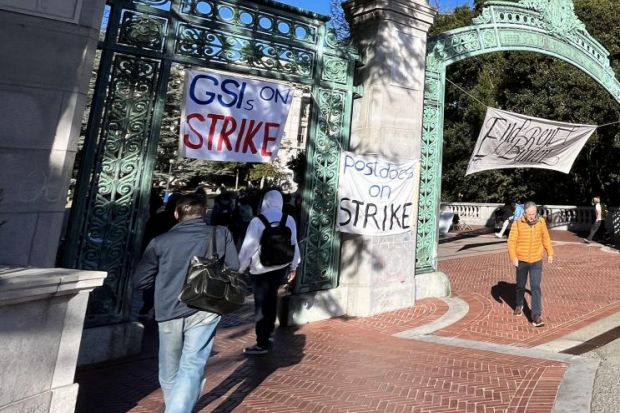Labour activism across US higher education is being driven by unusually high levels of graduate student workers upset by both pay and job conditions, and who have grown committed to forming unions, a new analysis has found.
The discontent has become evident to higher education leaders through a series of pro-union organising votes in the past two years, as well as strikes at institutions that include the University of California and Rutgers University.
A key driver behind that turmoil, according to an annual report from the National Centre for the Study of Collective Bargaining in Higher Education and the Professions at CUNY Hunter College, is the rising share of graduate-level student workers now willing to back unions.
An average of 91 per cent of eligible student workers voted in favour of unionisation in representation elections in 2022 and 2023, the centre reported. That’s well above the 75 per cent average share of pro-union votes cast by graduate workers in the period 2013 to 2019.
That level of support was “extremely high”, reflecting both economic and non-economic concerns over job conditions, said the centre’s director, William Herbert.
Major US institutions with successful union formations in the past two years include Yale University, the University of Chicago, Johns Hopkins University and the University of Minnesota – all of which saw failed attempts in the past, the centre said.
US higher education saw only four student worker strikes from 2013 to 2017 but has now experienced at least five a year since 2019, the centre said.
Private institutions appear especially ripe for uprisings. Nearly three quarters of the new student worker bargaining units formed in the last two years involved private colleges and universities, compared with the period before 2016, when nearly all new unions arose at public institutions, the centre said.
Union support in academia, though rising prior to the Covid pandemic, shot up after the shutdown altered workers’ expectations about what they should be willing to accept, Mr Herbert said.
Also “very unusual”, he said, was the growth of unionisation among undergraduate student workers, with at least three recent cases of undergraduates creating their own unions, getting the necessary federal approval and winning certification elections among their co-workers.
Pay levels are an important factor driving worker discontent at US colleges and universities, especially in locations with high housing costs. But many of the demands presented during negotiations are largely non-economic, Mr Herbert said, aimed at improving workplace conditions and protections, especially against various forms of harassment.
That combination of concerns had helped make higher education the sector of the US economy in which gains in union organising “have occurred on the largest scale to date”, the centre reported.
The Hunter College team issued its report on the same day that Yale’s president, Peter Salovey, announced his decision to step down at the end of the current academic year, just months after the university lost a decades-long battle to fend off the formation of a graduate worker union. In an interview, Professor Salovey said he respected the vote and expected to reach a contract with the union, saying that Yale also wanted working conditions that would allow the university to attract the best possible graduate students.
“We want them, and we want to be able to support them in a way that allows them to focus on their studies, their research and scholarship,” Professor Salovey said.
While the growth in union support across US higher education is relatively easy to measure, Mr Herbert acknowledged that it was considerably more difficult – probably impossible – to quantify actual success in contract negotiations. The University of California is a clear example: late last year, its graduate workers staged the largest-ever walkout in US higher education history, with more than 45,000 participants. But soon afterwards, many began complaining that they got fairly small gains in wages and some leaders spoke of contemplating another strike.
Register to continue
Why register?
- Registration is free and only takes a moment
- Once registered, you can read 3 articles a month
- Sign up for our newsletter
Subscribe
Or subscribe for unlimited access to:
- Unlimited access to news, views, insights & reviews
- Digital editions
- Digital access to THE’s university and college rankings analysis
Already registered or a current subscriber? Login








